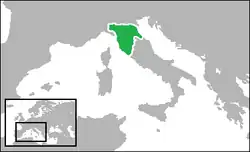United Provinces of Central Italy | |||||||||||||||
|---|---|---|---|---|---|---|---|---|---|---|---|---|---|---|---|
| 1859–1860 | |||||||||||||||
 Coat of arms
| |||||||||||||||
 The United Provinces of Central Italy (green) | |||||||||||||||
| Status | Client state of the Kingdom of Sardinia | ||||||||||||||
| Capital | Modena | ||||||||||||||
| Common languages | |||||||||||||||
| Government | Military government | ||||||||||||||
• King | Victor Emmanuel II | ||||||||||||||
• Governor General | Carlo Bon Compagni di Mombello | ||||||||||||||
• Appointed Regent | Eugenio Emanuele di Savoia-Carignano | ||||||||||||||
| Historical era | Late modern | ||||||||||||||
• Revolution | 8 December 1859 | ||||||||||||||
• Annexation | 22 March 1860 | ||||||||||||||
| Currency | Sardinian lira, Tuscan florin | ||||||||||||||
| |||||||||||||||
| Today part of | Italy | ||||||||||||||
The United Provinces of Central Italy (Italian: Province Unite del Centro Italia), also known as the Confederation of Central Italy or General Government of Central Italy, was a short-lived military government established by the Kingdom of Piedmont-Sardinia. It was formed by a union of the former Grand Duchy of Tuscany, Duchy of Parma, Duchy of Modena, and the Papal Legations, after the Second Italian War of Independence.
After August 1859, the pro-Piedmontese regimes of Tuscany, Parma, Modena and the Papal Legations agreed to several military treaties. On 7 November 1859, they elected Eugenio Emanuele di Savoia-Carignano as their regent. However, King Victor Emmanuel II of Savoy, who was allied to France which claimed a counterpart, refused to endorse the election, and sent Carlo Bon Compagni instead as the Governor General of Central Italy, who was responsible for the diplomatic and military affairs of the states.
On 8 December 1859, Parma, Modena and the Papal Legations were incorporated into the Royal Provinces of Emilia. After plebiscites were held during March 1860, and France was granted Nice and Savoy, the territory was annexed formally to Piedmont-Sardinia, as Bon Compagni resigned on 3 March 1860.
.svg.png.webp)
.svg.png.webp)
.jpg.webp)